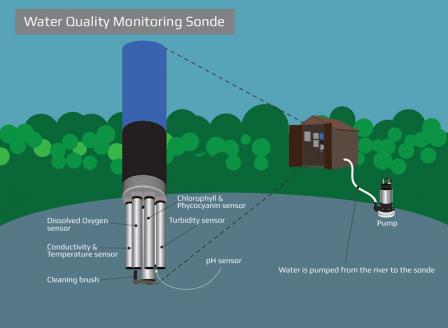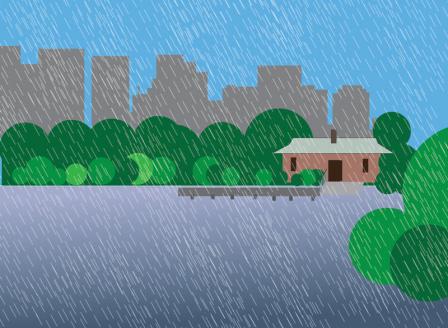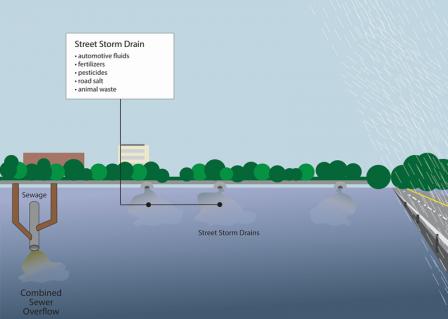Basic Information about the Lower Merrimack River Monitoring Station
Station Monitoring Sampling Equipment
Data Stream
Water monitoring station in the Lower Merrimack River in the Lawrence section of the river.
Every 15 minutes, from December 2016 through November 2018, the station received information from a sonde that is in the river. A sonde is an instrument with sensors that takes environmental measurements. The information was transmitted in near real-time using telemetry for remote access on EPA's website. EPA scientist and water quality managers use the data from this station to assess and understand water quality conditions.
The sensors are connected to the monitoring station and located 1 meter below the water's surface and measure the following:
- temperature
- dissolved oxygen
- specific conductance (conductivity)
- pH
- turbidity
- chlorophyll
- phycocyanin
Water Surface
Wet weather, or rain, can cause several changes in water quality in the Lower Merrimack River. A high intensity storm will often trigger discharges from Combined Sewer Overflows (CSOs) which carry fecal matter and other pollutants into the river. These discharges increase the amount of suspended (neither sinking nor floating) material in the Lower Merrimack River and can increase the measurement of turbidity. It will also dramatically increase bacterial concentrations (which are not measured by the sonde) in the watershed.
Most rain events cause the discharge of stormwater through many stormwater outfalls in the Lower Merrimack. Because stormwater flushes dirt and other surface pollutants into the river, higher turbidity readings can occur. If rain occurs during hot summer weather, it may cause a temporary increase in water temperature; this is a result of stormwater being heated as it flows over hot impervious surfaces such as streets, roofs and parking lots on its way to the river and tributaries. Higher water temperatures will increase the likelihood of algal blooms. This will be indicated by increasing chlorophyll and phycocyanin measurements from the sondes.
Algal Blooms
Nutrients, primarily phosphorus, are a chief culprit for dramatic algae blooms that can plague the watershed with blue-green algae during the summer months.
These "blue-green" algae blooms, are a form of bacterial known as cyanobacteria, whose cells may release a toxin when they die. Exposure to the toxin can cause skin rashes and irritate the nose, eyes or throat, and if ingested can lead to serious liver and nervous system damage. Other harmful effects of the algae include reduced water clarity, nuisance scum, and reduced oxygen in the water which is necessary for a healthy fish habitat.
Water Quality
Urban Runoff View
Storm drain pipes and Combined Sewer Overflows (CSOs) have long been a culprit for discharge of pollutants into urban waterways like the Lower Merrimack River and its watershed. Street storm drains can carry automotive fluids, fertilizers, pesticides, road salt and animal waste with rain water that can pollute the river. CSOs occur when the sewer system is overloaded and wastewater is carried through the stormwater pipes and discharged into the river.




